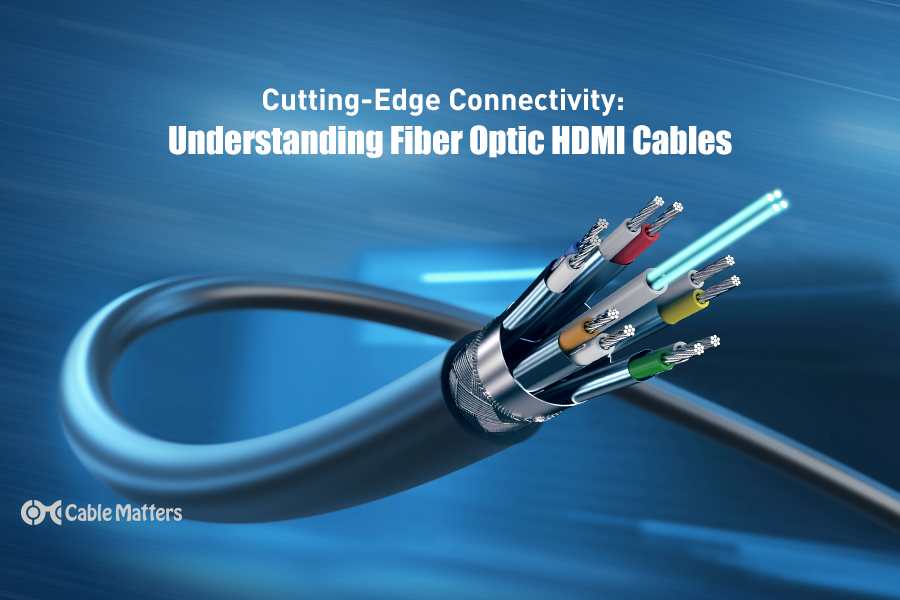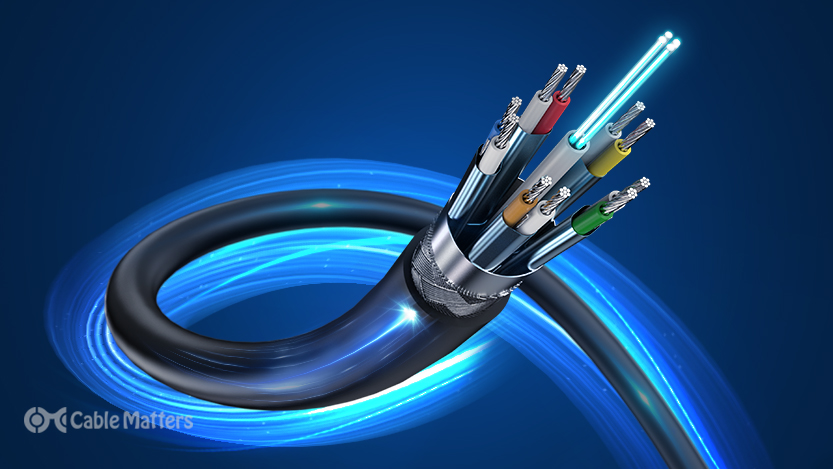
When even a high-quality HDMI 2.1 cable just won’t do, you need to break out the big guns. Fiber Optic HDMI cables use the same HDMI protocol as standard HDMI cables but use a different construction method to make an altogether more capable cable. Fiber Optic HDMI cables use glass fibers to transmit the data at the speed of light, enabling much longer HDMI cables and more robust shielding against outside interference.
They are more expensive than their copper counterparts, though, and are typically overkill for most domestic settings. If you are in need of a particularly long HDMI cable, though, a fiber optic HDMI cable might be what you need.
What Is a Fiber Optic HDMI Cable?
A standard HDMI cable is made up of several twisted pairs of copper wiring, insulated and protected with shielding and silicon wraps. A fiber optic HDMI cable, on the other hand, does away with the central twisted copper pair, but still retains some. At its core are four glass filaments which are encased in a protective coating. Those glass strands transmit the data as pulses of light, instead of electricity.

Surrounding those glass fibers are seven to nine twisted copper pairs that handle the power supply for the cable, one for Consumer Electronics Control (CEC), two for sound return (ARC and eARC), and one set for a Display Data Channel (DDC) signal.
Fiber optic cables are far less susceptible to signal interference, noise, and crosstalk, due to using light rather than electricity to transmit the data. It has a converter at each end to allow the source to transmit the data and the display to translate it.
All fiber optic HDMI cables are active, meaning they only operate in one direction and aren’t reversible. Their construction materials mean they tend to end up lighter than traditional HDMI cables. However, their additional shielding often makes them thicker, which can lead to some difficulties with installation when the environment is tight or busy with other cables.
They also tend to be more expensive than traditional HDMI cables too, so they aren’t always the best solution – especially if you only need a short run of HDMI cable where a typical copper cable will suffice.
Advantages of Fiber Optic HDMI cables
Fiber optic HDMI cables offer a number of advantages over traditional copper twisted pair HDMI cables. The first and most dramatic, is their available lengths. Fiber optic HDMI cables suffer so much less interference, and the signal, so little attenuation down the length of the cable, that fiber optic cables can be extremely long in comparison. Where a standard HDMI cable made from twisted copper wires can reach up to 30ft in some generations – though more like nine feet for passive HDMI 2.1 cables – fiber optic HDMI cables can run for 1000 feet or more.
This is doubly important when it comes to high-speed HDMI cables. Although the latest generation, HDMI 2.1, offers the greatest data rates yet for any HDMI connection, they are the shortest HDMI cables, too. Fiber optic cables do not suffer from this problem, so you can get really, really long HDMI 2.1 cables built around fiber optic technology. That lets you take full advantage of the latest features as well as the higher performance of the latest standards, even at extreme lengths.

That makes fiber optic HDMI cables the perfect solution for reaching far-flung displays, like billboards, bar TVs, shopfront displays, and more, where a traditional HDMI cable just wouldn’t reach, or wouldn’t be able to transmit a high-resolution image at that distance.
However, that doesn’t mean you don’t ever want to use fiber optic HDMI cables for shorter distances. Cable Matters makes a number of cables that are just a few meters in length because those same advantages over a distance are equally useful in closer proximity, too.
Fiber optic cables are not only more robust in themselves, but offer extensive shielding against electromagnetic interference, noise, and crosstalk. Far more so than any copper HDMI cables. That makes them an excellent solution in professional or enterprise settings where the sanctity of the video being transmitted is of the utmost importance.
The latest generations of fiber optic HDMI cables have full support for 4K and 8K resolution, as well as high refresh rates, support for HDR, and eARC support (it’s much better than using optical cables). Although higher resolution and refresh rate displays are not yet available, the HDMI 2.1 standard can theoretically support up to 10K resolution at 120Hz when utilizing display stream compression and chroma subsampling.
Factors to Consider When Choosing Fiber Optic HDMI Cables
The factors to consider when buying a fiber optic HDMI cable are mostly the same as those of traditional HDMI cables – meaning you should always consider that more affordable standard first. Especially, since fiber optic cables can grow prohibitively expensive at the lengthier reaches.
The first, and most important consideration is HDMI generation. Thanks to the backward compatibility of HDMI you can just use the latest generation – HDMI 2.1 – and have full feature support and the best performance possible from any HDMI-supporting device. However, if you are trying to run a 1080p display from a source that only supports HDMI 1.4, then using an HDMI 2.1 cable is complete overkill and you won’t be able to utilize features like ARC, automatic low latency mode, dynamic HDR support, or quick frame transport, among others.
HDMI 2.1 cables tend to be more expensive than their older counterparts, especially at extreme distances, so you’d be wasting money if you simply bought the absolute best if it’s more than you need. Look at the HDMI versions of the display and devices you want to connect and match that as best you can. You can always buy newer if there isn’t much cost difference, as newer HDMI generations always support older ones, but it doesn’t work both ways, so bear that in mind.
The next aspect to consider is cable length. Fiber optic HDMI cables can run far longer than their copper twisted pair counterparts, so if you need an especially long HDMI cable, then fiber optic is going to be your best (and possibly only) option. That said, that doesn’t mean you should buy a fiber optic HDMI cable no matter what length of cable you’re after. If you only need an HDMI cable that is 30 feet or shorter, then there’s a good argument for merely using a traditional HDMI cable instead. They’re simply much cheaper, making them a more worthwhile investment if that’s all you need.
That being said, if you have a cable run that is on the cusp of standard HDMI cables’ abilities, then opting for a fiber optic cable may be the more prudent decision. Not only will it give you some wiggle room so you can run the cable in an opportune way – instead of using merely the shortest route from device to display – but you’ll ensure that the signal doesn’t lose any of its quality if interference is a particular problem.
Cost is another major factor when choosing a fiber optic HDMI cable. Fiber optic cables that are only a fraction longer than a traditional HDMI counterpart can cost more than twice as much. It’s your only real option when it comes to really long HDMI cables, so the added cost of expensive cables is just something to consider.
Do note also, that though fiber optic HDMI cables can support all of the features of traditional HDMI cables – such as ARC and eARC – not all fiber optic HDMI cables do support them. If you want to use a particular feature of an HDMI cable generation, be sure that any fiber optic cable you purchase also has full support for it.
As with any cable, make sure that when choosing a fiber optic HDMI cable, that you pick one from a reputable cable manufacturer like Cable Matters. That ensures that you get a robust cable built to the highest standards, that will last you for years to come.

Conclusion
HDMI cables are still one of the most popular and versatile cables for connecting source devices to displays, and active fiber optic HDMI cables play a major part in that dynamic. They’re what allow HDMI technology to be used in extreme-length cable scenarios, where typical HDMI cables, and those of other display standards, just wouldn’t cut it.
Although fiber optic HDMI cables do tend to be more expensive, they offer the full ease of use, compatibility, performance, and feature support of standard HDMI cables, but with the added advantage of working over distances as long as hundreds of feet. Running a single one of those cables is so much easier than running multiple HDMI cables with repeaters along the same route.
You don’t need a fiber optic HDMI cable if you only need to run a cable a few meters, or if you’re putting together a home A/V setup that’s not too expansive. But if you have a display and a source device that are far apart, then fiber optic HDMI cables are a great way to bring them together.